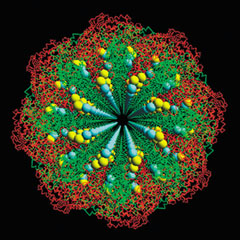Investigators at Georgia Institute of Technology in Atlanta and Florida International University (FIU) in Miami reveal how research in nanotechnology has increasingly become a multi-national enterprise, despite having some 60 countries now funding nanotech initiatives within their borders. Phillip Shapira of Georgia Tech and Jue Wang of FIU found nearly a quarter of all published nanotech research papers co-authored by multi-national collaborators.
Shapira and Wang used data mining techniques to study authorship and funding acknowledgments available in the Web of Science, a leading international database of scientific publications, between August 2008 and July 2009. Their analysis covered more than 91,000 papers. Their findings appear online in Nature magazine (paid subscription required).
The findings show the authors of papers came from 152 countries, but authors from only four countries — U.S., China, Germany, and Japan — account for 61 percent of the total. The U.S. (23%) and China (22%) are the leading producers of nanotechnology research, but papers with multinational authors were just as common, also at 23 percent. Papers with multinational authoring teams were assigned to multiple countries.
While the U.S. and China authors had published almost equal numbers of nanotechnology papers, Shapira and Wang found the U.S. registered a qualitative edge in those papers. Research by U.S. scientists had more early citations than the Chinese papers, and U.S. corporate involvement in commercialization and innovation is well ahead of China. But Shapira notes that China is improving in both areas.
Despite the tendency to view measures of research productivity as a form of national competition, the findings indicate the U.S. and China have become each other’s most frequent international collaborators. About three percent of U.S. papers reported co-funding from the Chinese National Natural Science Foundation, while a similar proportion of Chinese papers report co-funding from the U.S. National Science Foundation.
“Although these numbers are still low relative to purely nationally-funded papers,” says Shapira, “they signal a significant trend as China has taken over from European countries as America’s leading international collaborator by volume in nanotechnology research.”
Related: Univ. Nanotech Center Opens Collaborations in Japan
* * *


 RSS - Posts
RSS - Posts
[…] This post was mentioned on Twitter by Alltop Science, Alan Kotok. Alan Kotok said: More International Collaboration Found in Nanotech Research | #Science #Business http://t.co/0GhRGYn #ScienceBusiness […]
[…] Read More: More International Collaboration Found in Nanotech Research […]